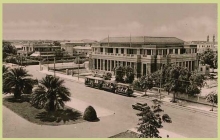
In the past, some of the functions of the Central Bank of Sudan were divided between the Ministry of Finance, Sudan Currency Board and the National Bank of Egypt .The Ministry of Finance maintained part of the official foreign exchange balances through two accounts, one in USD and the other in Sterling Pounds which were managed respectively by the National Bank of Egypt and Barclays Bank D.C.O. As to the currency Board it used to perform the task of issuing and managing the currency and to keep a part of the country's balance in foreign currency as a cover to the national currency.
Also the branch of the National Bank of Egypt used to manage the banking activities of the government besides discharging its main role as the bank of commercial banks (bank of the banks) at the same time. During this period, the Egyptian and British currencies were prevailing until the first national currency was issued.
After the independence of Sudan, the need for having a Central Bank to replace the existing bodies and to perform its functions of regulating the process of the issuance of the national currency , formulating and directing monetary and finance policies to serve various economic sectors , build up a strong , efficient and effective banking system that meet the development needs of the country, maintain government accounts , act as adviser for the government on financial affairs and provide foreign currency for the development projects adopted by the government at that time. To achieve the abovementioned objectives, a committee of three experts from the USA Federal Reserve was formed in December 1956.
The experts were:
- Oliver Weale , Vice chairman of the Federal Reserve Bank of Francisco as president,
- Alan R. holmes from the Federal Reserve Bank of New York as a member.
- Andrew F.Primer from the Federal Reserve Bank of New York as a member.
The Committee was requested to conduct a study on the possibilities of establishing a Central Bank in Sudan. It submitted its report in March 1957. This was followed by the issuance of the Bank of Sudan Act of 1959. The Bank opened for business on February 22, 1960.
The Act stipulated that the Bank of Sudan shall have an independent corporate personality, legal personality and a perpetual succession and a common seal and may litigate in its own name as a plaintiff defendant. Following the establishment of the Bank of Sudan, Sudanese officials were appointed to replace Egyptian officials, while the junior staff that used to work for the National Bank of Egypt were retained .The first Governor of Bank of Sudan was His Excellency / Mamoun Behairy.
Due to the especial nature and purpose of the Central Bank, a number of qualified employees with university degrees were recruited, in addition to those who were seconded from the Ministry of Finance.
